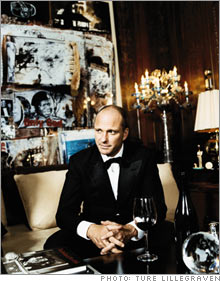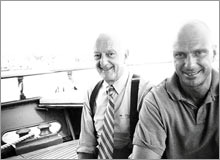Scandal shakes up the Cipriani empireGiuseppe Cipriani - playboy and bon vivant - tries to transform his family restaurant business into a worldwide luxury brand and avoid the taint of scandal. Fortune's John Brodie reports.(Fortune Magazine) -- On a cold January night, Giuseppe Cipriani steps out of a Rolls-Royce and into the side entrance of what once was the Bowery Savings Bank. His family converted this ornate 1923 building opposite Grand Central Station into one of New York City's leading event spaces in 1998. A scrum of paparazzi jostle for position beneath the four-story archway, hoping to catch a glimpse of the boldface names - Sharon Stone, Whoopi Goldberg - who are heading into a benefit for amfAR, the AIDS charity. Dressed in a conservative blue suit, the 41-year-old restaurateur has spent the day meeting with bankers in Greenwich, Conn. He nods to a security guard before taking the elevator up five floors to a warren of wood-paneled offices that he's converted into a combination of corporate headquarters and bachelor pad.
The divorced father of two teenage boys strides past an antique pool table littered with architectural drawings and the model of a Riva speedboat and disappears into the dark recesses of his Bat Cave. Moments later he reappears in a bespoke tuxedo, a piqu� shirt and black opera pumps. There are 500 hungry socialites to feed (or at least serve dinner to), and as Tracy Chapman finishes belting out a cover of "Stand by Me" in what once was the bank's lobby, Cipriani heads down a stairway to a basement kitchen. Here, 100 waiters in white dinner jackets are poised to load up their platters with filet mignon, haricots verts and roast potatoes. "Eight and a half minutes," he says, not estimating but announcing how long it will take for all the waiters to get the grub on the table. Cipriani 42nd Street is currently the second-largest venue in his growing restaurant and catering empire (the largest, at 55 Wall Street, seats more than 1,000). The 42nd Street site hosts 250 events like this (weddings, awards banquets, charity benefits) a year, sometimes three a day. Patrons shell out $200 to $300 per person to get a respite from the rubber-chicken circuit and enjoy Cipriani signatures, including risotto alla primavera and the Bellini cocktail (a concoction of white peach juice and prosecco). Giuseppe moves between the staff below-stairs and celebrities above with the confidence that comes from being the third generation of his family in the hospitality business. "In the house growing up, the conversation was, 'How many covers did we do tonight?,' 'Were there any complaints?,' 'Who was in the restaurant?,'" he says of his childhood in Venice. "To me running a restaurant is the same as having a guest in your house: You need to make people feel comfortable." Cipriani (pronounced "Chip-ree-on-nee") still speaks with a slight Italian accent even though he moved to New York when he was 20. Besides catering halls, the family owns seven and a half restaurants, stretching from New York to Hong Kong ("The half is Sardinia, which is open only in the summer"). The total revenue for Cipriani USA in 2006 was roughly $140 million. Not huge, but Giuseppe is currently making some hundred-million-dollar moves to transform a cult name among the glitterati into a global luxury brand by building hotels in Beverly Hills and Miami. Yet at the very moment that he is building his brand, Cipriani has had to watch the family name dragged through the mud after the New York City tabloids linked him to members of organized crime last summer. "Listen, you cannot be in the restaurant business in New York and not have that stuff come up once in a while," says Stanley S. Arkin, a criminal defense attorney who is a longtime friend and occasional legal adviser of Cipriani's. "But what you have here is an extraordinary man who could become the Ralph Lauren of the restaurant world." This summer Cipriani and several partners will break ground on a $300 million-plus project to turn Miami's dilapidated Saxony hotel into a five-star complex called the Cipriani Ocean Resort & Club Residences. One tower will be a hotel, the other condos ranging from 1,200 to 10,000 square feet (at $1.5 million to $30 million each). The facilities will include two pools, a 600-foot-wide private beach and an event center. Beyond South Beach, he is in the preliminary stages of a $70 million-plus renovation of a 12-story mid-'60s hotel on the outskirts of Beverly Hills. "Then we have to go to Chicago, London, Moscow, S�o Paulo. These are the cities where our name can make a difference," he says of his plans to conquer the chicest precincts of the globe. These days Credit Suisse (Charts) and Deutsche Bank (Charts) (the former holds the debt on the Miami project, the latter on L.A.) appear on his call sheet as regularly as De Cecco, the Italian pasta company that distributes the family's food line. The bankers are bullish on Cipriani, even though the Miami hotel and condo market may be reaching the saturation point. "We don't particularly like South Beach, because we're concerned that it has run too far too fast, but we like Giuseppe enough that we got comfortable with the deal," says Andy Stone, a managing partner at the hedge fund Petra Capital, which is an investor in the project. Or as another leading real estate banker said when asked to sum up the allure of the Cipriani brand, "We've backed [boutique hotel owners] Andrew Balazs and Ian Shrager in the past, but the guy who has the most long-term potential is Giuseppe." Like the grandfather for whom he is named, Cipriani has a knack for turning patrons into partners. In fact, the family owes its entry into the food service business to that very skill. In the fall of 1929, Giuseppe the Elder was a barman at the Hotel Europa in Venice when he met an American student named Harry Cushing. Strapped for cash, Cushing hit the barman up for 10,000 lire ($6,000 today). He then disappeared, leaving Cipriani worried that he'd never see his money again. However, the American returned in February 1930, and he not only repaid Cipriani but offered to put up $24,000 for the pair to set up their own place. The following year they opened Harry's Bar in an old warehouse at the end of a dead-end street near the Piazza San Marco. The decor was nautical and simple, the service elegant but seemingly effortless. And writers and other tastemakers found it a comfortable watering hole. By the 1950s Harry's Bar had become a place where stars, no-account counts and other jet-setters mingled. |
Sponsors
|




